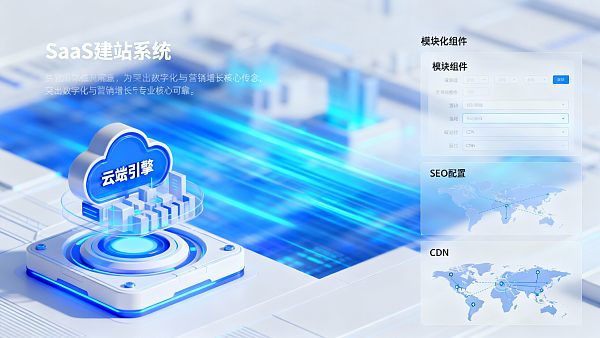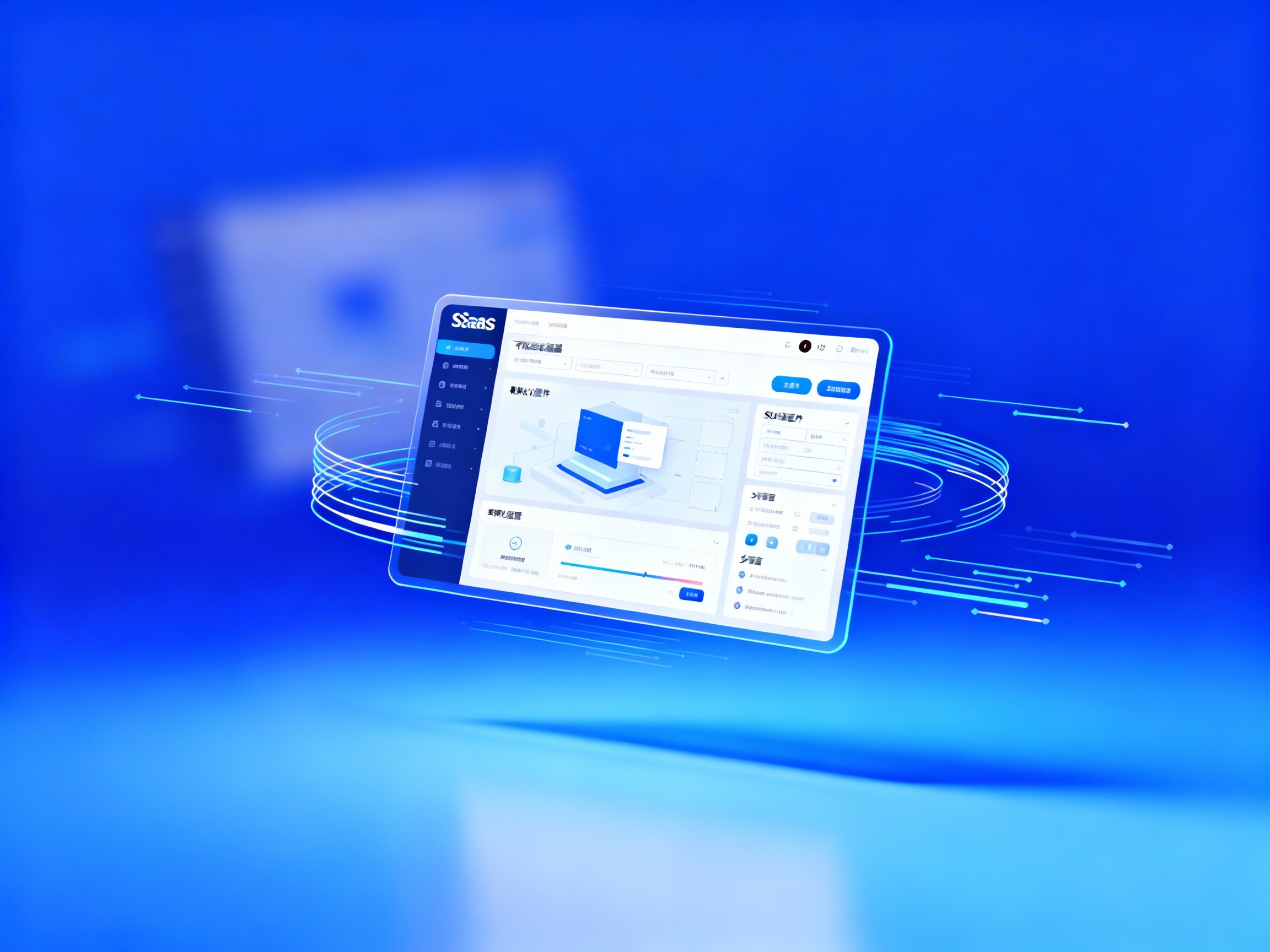Easy Camp Cloud Intelligent Website Construction and Marketing System Platform!
1. Definition of SaaS Website System
SaaS Website System (Software as a Service Website Builder) is a cloud-based software service that provides website construction, template design, hosting deployment, content management, plugin extensions, and marketing tools in a rental service format. Users can complete page design, content publishing, SEO configuration, and third-party integrations directly through a browser without the need for local server deployment or writing large amounts of code. The SaaS model shifts the responsibility of infrastructure, updates, maintenance, security protection, and feature iterations to the service provider, allowing businesses to subscribe on-demand for continuous usage.
2. Development History and Evolution
The rise of SaaS website building is closely tied to the development of the internet and cloud computing. Early website construction often relied on custom development and self-built servers, resulting in long development cycles and high maintenance costs. With the maturation of cloud services and multi-tenant architectures, the first generation of visual website builders and template platforms emerged, enabling users to quickly assemble websites using templates, albeit with limited functionality and scalability.
With the advent of the mobile internet and social commerce era, market demand for rapid deployment, continuous iteration, and marketing closed-loop solutions surged, driving SaaS website platforms toward deeper integration: embedding SEO tools, data analytics, marketing automation, multilingual internationalization support, and e-commerce capabilities. In recent years, AI text generation, intelligent image processing, and low-code components have ushered SaaS website building into a new phase of intelligence, modularity, and industry specialization, catering to professional needs in sectors like foreign trade, manufacturing, education, and e-commerce.
3. Technical Principles

The core technical principles of SaaS website systems include multi-tenant architecture, frontend-backend separation, responsive design, visual editors, modular components, API and third-party integrations, as well as cloud-based automated operations:
1. Multi-tenant architecture: Provides independent site instances for multiple clients on the same software platform, enabling resource isolation and cost-sharing while facilitating unified upgrades and maintenance.
2. Frontend-backend separation: The frontend handles interface rendering and interactions, while the backend manages data storage and business logic, improving development efficiency and enabling flexible extensions.
3. Responsive layout and componentization: Uses fluid grids, media queries, and modular components to ensure optimal display effects across PCs, tablets, and mobile devices.
4. Drag-and-drop visual editor: A WYSIWYG page-building tool that allows non-technical users to configure page structures and styles by dragging components.
5. API and third-party integrations: Offers open APIs and plugin marketplaces supporting payment gateways, CRM, email services, ad pixels, and third-party analytics tools to form marketing closed loops.
6. Cloud operations and automation: Includes automated backups, auto-scaling, CDN distribution, and disaster recovery mechanisms to ensure high availability and global access speeds.
4. Technical Features and Core Capabilities
A mature SaaS website system typically possesses the following technical features, which determine its ability to support enterprise digitalization and SEO:
1. Templating and industry-specific templates: Provides industry-specific templates (e.g., foreign trade, manufacturing, education, e-commerce) to accelerate deployment with built-in optimization recommendations.
2. Native SEO support: Automatically generates SEO-friendly URLs, meta tags, sitemaps, structured data (Schema), hreflang multilingual tags, and mobile-first layouts to improve search engine indexing.
3. Multilingual and localization: Supports language packs, currencies, and localized content management to align with GEO searches and local user preferences.
4. High availability and global acceleration: Leverages CDN, edge nodes, caching strategies, and mirror deployments to ensure overseas access speeds and stability.
5. Marketing integration capabilities: Built-in forms, CRM, email marketing, automation workflows, ad pixels, and e-commerce plugins to support lead acquisition and conversion closed loops.
6. Security and compliance: SSL encryption, WAF firewalls, DDoS protection, access controls, and privacy compliance support (e.g., GDPR).
7. Extensible plugin ecosystem: Supports third-party extensions and custom development to meet specialized business requirements.
5. Application Scenarios and Industry Use Cases

SaaS website systems are widely applicable, particularly effective in the following scenarios:
1. Foreign trade independent sites: Multilingual support, SEO optimization, and global CDN help foreign trade businesses gain stable traffic and inquiries via Google and GEO platforms.
2. Cross-border e-commerce brand sites: Integrates e-commerce plugins, payment gateways, and logistics interfaces to provide product displays, ordering, and localized settlement capabilities.
3. SME corporate websites: Enables rapid deployment of corporate showcase pages through templating and visual editing, achieving low-cost online presence and continuous content operations.
4. Marketing landing pages and ad pages: Supports A/B testing, form embedding, and conversion tracking for ad landing page optimization.
5. Educational institutions and training: Features course displays, registration forms, multilingual enrollment pages, and online payment functionality.
6. SaaS and tech service providers: Showcases product introductions, trial applications, and user documentation hosting.
6. Business and SEO Advantages of SaaS Website Systems
SaaS website systems are not just technical platforms but also business growth tools. Their SEO and GEO advantages include:
1. Rapid deployment, increasing time value: Templates and visual editing allow businesses to go live within days, capturing market opportunities.
2. Unified tech stack for better search engine crawling: Fixed site structures and standardized Schema help search engines better understand content, improving indexing rates.
3. Data-driven optimization: Integrated analytics and event tracking help marketing teams optimize landing pages and ad strategies for sustained conversion improvements.
4. Cost control: Subscription models eliminate high upfront investments and server maintenance costs.
7. Comparative Analysis with Other Website Building Models
Below is a comparison between SaaS website systems and traditional custom development, self-hosted servers, and open-source CMS to aid business decision-making:
1. SaaS vs. custom development: Custom development excels in personalization but suffers from high costs, slow deployment, and complex maintenance, whereas SaaS emphasizes speed, low cost, and continuous iteration.
2. SaaS vs. self-hosted open-source CMS (e.g., WordPress): Self-hosted solutions offer flexibility but burden users with heavy operational and security responsibilities, plus plugin conflicts; SaaS provides managed services with automated upgrades and reliable security.
3. SaaS vs. template websites: Template sites often have limited functionality and scalability, while SaaS offers plugin ecosystems and APIs to meet long-term business needs.
4. SaaS vs. low-code platforms: Low-code platforms focus on internal workflows and applications, making them better suited for enterprise tools; SaaS website builders specialize in external traffic and marketing conversions.
8. Industry Deep-Dive Case Studies (Examples)
1. Manufacturing export businesses: Use SaaS systems to build multilingual product catalogs, case libraries, and inquiry forms, combining Google SEO and LinkedIn promotions to convert traffic into inquiries.
2. Cross-border DTC brands: Leverage SaaS e-commerce plugins integrated with Shopify or proprietary payments, paired with Meta ads and email automation for repeat purchases and brand maintenance.
3. Education and training institutions: Utilize SaaS landing pages, online registration, and payment modules to quickly launch campaign pages and acquire long-term leads via SEO and content marketing.
9. Certifications and Compliance Requirements
Professional SaaS website platforms must meet multiple technical and compliance standards to ensure legal and secure global operations:
1. Data security and privacy compliance: Adheres to regional privacy laws like GDPR and CCPA, providing data export and deletion features to protect user privacy rights.
2. Payment and financial compliance: Payment integrations must meet PCI-DSS card industry security standards.
3. W3C and accessibility standards: Ensures semantic pages, compatibility, and barrier-free access (WCAG).
4. Security certifications: SSL/TLS, WAF, DDoS protection, anti-crawling, and regular security audits.
5. SEO and structured data norms: Implements Schema markup, Open Graph, and Twitter Cards to enhance search engine and social media display effects.
10. Implementation Recommendations and Best Practices
For businesses preparing to adopt SaaS website systems, we recommend starting with the following aspects to ensure long-term effectiveness and ROI:
1. Define business goals: Clarify whether the primary focus is brand display, lead acquisition, or e-commerce conversion, then select a platform with matching capabilities.
2. Prioritize SEO and content strategy: Choose platforms supporting structured data, auto-generated sitemaps, and multilingual hreflang tags, while developing long-term content plans.
3. Validate performance and global access: Test CDN node coverage and overseas access speeds to ensure target market user experience.
4. Data and security compliance: Confirm platform adherence to GDPR, PCI, and other regulations while ensuring data export permissions.
5. Assess extensibility: Verify support for custom code, API calls, and third-party integrations to avoid future scalability bottlenecks.
How SaaS Website Systems Become Long-Term Assets
SaaS website systems are not just building tools but enablers of enterprise digitalization. By selecting SaaS platforms that meet business and compliance needs, combined with long-term content operations, SEO strategies, and data-driven decisions, businesses can establish sustainable online lead acquisition and brand growth mechanisms at lower costs and higher efficiency. In the global competitive landscape, SaaS website systems will continue providing dual technical and commercial support, becoming enterprises' long-term digital assets.
Choose a professional SaaS website system today to accelerate your brand's global visibility. Zero-code rapid deployment, automated SEO optimization, multilingual support, and global acceleration help businesses reduce customer acquisition costs, improve inquiry conversions, and enhance brand professionalism. Quick online deployment, worry-free operations, and integrated marketing tools with analytics enable closed-loop growth from traffic to orders. Start building your internationalized website now to seize digital dividends.
FAQ
Question 1: Are SaaS website systems suitable for large enterprises?
Answer: Yes. Modern SaaS platforms offer enterprise editions and private deployment solutions, supporting high concurrency, high customization, and compliance requirements. Large enterprises should evaluate SLA commitments, customization capabilities, and data isolation strategies when selecting a provider.
Question 2: Can platform data be exported? If switching platforms, is data migration difficult?
Answer: Premium SaaS platforms typically support data exports (e.g., content, user, and product data). Migration difficulty depends on data structures and third-party dependencies. Choosing platforms with standard export formats significantly reduces migration costs.
Question 3: Do SaaS websites pose security risks? How are they mitigated?
Answer: All internet services carry risks. Reliable SaaS platforms employ SSL, WAF, DDoS protection, regular penetration testing, and log audits. Enterprises should additionally configure strong passwords, two-factor authentication, and access controls.
Question 4: Do SaaS website systems assist with SEO?
Answer: Yes. Quality SaaS platforms feature built-in SEO tools, structured data, mobile-first support, and performance optimization—all conducive to improving search engine indexing and rankings. However, long-term rankings still require content and backlink strategies.

Customer Reviews
Customer Review 1:
After our foreign trade company adopted the SaaS website system, the organic traffic of our English and Spanish websites nearly doubled within three months, and the quality of inquiries significantly improved. The platform's multilingual management and CDN support were key factors.
Customer Review 2:
Choosing the SaaS website system helped us save substantial operational costs. The marketing team can quickly launch campaign pages and conduct A/B testing independently, resulting in a notable increase in conversion rates.


